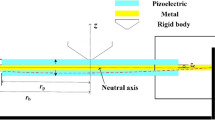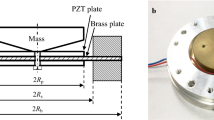Abstract
A piezoelectric energy harvester is investigated with the focus on its nonlinear behavior. The harvester consists of a circular composite plate with the clamped boundary, a proof mass and two steel rings. A reduced-order model of the harvester is established, and the parameters are identified from the experimental data. A technique is proposed to identify electrical parameters with the outcomes agreeing with the theoretical values, and a fifth-order polynomial is employed to approximate the nonlinear restoring force. Both the experimental and the numerical results demonstrate that the harvester changes its characteristic from linearity to a softening nonlinearity and finally to a combined softening and hardening nonlinearity as the excitation increases from low to high.











Similar content being viewed by others
References
Kaur, N., Bhalla, S.: Combined energy harvesting and structural health monitoring potential of embedded piezo-concrete vibration sensors. J. Energy Eng. 141(4), D4014001 (2014)
Jiang, X.Z., Wang, J., Li, Y.C., Yao, J.: Energy harvesting for powering wireless sensor networks in low-frequency and large-force environments. J. Mech. Eng. Sci. 229(11), 1953–1964 (2015)
Erturk, A., Inman, D.J.: Piezoelectric Energy Harvesting. Wiley, Chichester (2011)
Elvin, N.G., Elvin, A.A.: An experimentally validated electromagnetic energy harvester. J. Sound Vib. 330(10), 2314–2324 (2011)
Le, C.P., Halvorsen, E., Sen, O.S.R., Yeatman, E.M.: Microscale electrostatic energy harvester using internal impacts. J. Intell. Mater. Syst. Struct. 23(13), 1409–1421 (2012)
Adly, A., Davino, D., Giustiniani, A., Visone, C.: Experimental tests of a magnetostrictive energy harvesting device toward its modeling. J. Appl. Phys. 107(9), 09A935 (2010)
Belhora, F., Cottinet, P.J., Guyomar, D., Petit, L., Lebrun, L., Hajjaji, A., Maroubi, M.H., Boughaleb, Y.: Optimization of energy harvesting conversion using the hybridization of electrostrictive polymers and electrets. Sens. Actuat. A Phys. 189(2), 390–398 (2013)
Elvin, N., Erturk, A.: Advances in Energy Harvesting Methods. Springer, New York (2013)
Yang, Z.B., Zu, J.: High-efficiency compressive-mode energy harvester enhanced by a multi-stage force amplification mechanism. Energy Convers. Manag. 88, 829–833 (2014)
Stanton, S.C., Erturk, A., Mann, B.P., Inman, D.J.: Nonlinear piezoelectricity in electroelastic energy harvesters: modeling and experimental identification. J. Appl. Phys. 108(7), 074903 (2010)
Erturk, A., Inman, D.J.: A distributed parameter electromechanical model for cantilevered piezoelectric energy harvesters. J. Vib. Acoust. 130(4), 1257–1261 (2008)
Stanton, S.C., Erturk, A., Mann, B.P., Dowell, E.H., Inman, D.J.: Nonlinear nonconservative behavior and modeling of piezoelectric energy harvesters including proof mass effects. J. Intell. Mater. Syst. Struct. 23(2), 183–199 (2012)
Abdelkefi, A., Hajj, M.R., Nayfeh, A.H.: Phenomena and modeling of piezoelectric energy harvesting from freely oscillating cylinders. Nonlinear Dyn. 70(2), 1377–1388 (2012)
Wang, S., Lam, K.H., Sun, C.L., Kwok, K.W., Chan, H.L.W., Guo, M.S., Zhao, X.Z.: Energy harvesting with piezoelectric drum transducer. Appl. Phys. Lett. 90(11), 113506 (2007)
Yuan, T.C., Yang, J., Song, R.G., Liu, X.W.: Vibration energy harvesting system for railroad safety based on the running vehicles. Smart Mater. Struct. 23(12), 125046 (2014)
Kim, S.W., Clark, W.W., Wang, Q.M.: Piezoelectric energy harvesting with a clamped circular plate: analysis. J. Intell. Mater. Syst. Struct. 16(10), 847–854 (2005)
Kim, S.W., Clark, W.W., Wang, Q.M.: Piezoelectric energy harvesting with a clamped circular plate: experimental study. J. Intell. Mater. Syst. Struct. 16(10), 855–863 (2005)
Zhao, X., Yang, T.Q., Dong, Y., Wang, X.C.: Energy harvester array using piezoelectric circular diaphragm for broadband vibration. Appl. Phys. Lett. 104(22), 223904 (2014)
Wang, W., Huang, R.J., Huang, C.J., Li, L.F.: Energy harvester array using piezoelectric circular diaphragm for rail vibration. Acta Mech. Sin. 30(6), 884–888 (2014)
Yuan, J.B., Xie, T., Chen, W.S., Jiang, S.N.: Performance of a drum transducer for scavenging vibration energy. J. Intell. Mater. Syst. Struct. 20(14), 1771–1777 (2009)
Abdelkefi, A., Nayfeh, A.H., Hajj, M.R.: Global nonlinear distributed-parameter model of parametrically excited piezoelectric energy harvesters. Nonlinear Dyn. 67(2), 1147–1160 (2012)
Ramlan, R., Brennan, M.J., Mace, B.R., Kovacic, I.: Potential benefits of a non-linear stiffness in an energy harvesting device. Nonlinear Dyn. 59(4), 545–558 (2010)
Erturk, A., Hoffmann, J., Inman, D.J.: A piezomagnetoelastic structure for broadband vibration energy harvesting. Appl. Phys. Lett. 94(25), 254102 (2009)
Wu, H., Tang, L.H., Yang, Y.W., Soh, C.K.: Development of a broadband nonlinear two-degree-of-freedom piezoelectric energy harvester. J. Intell. Mater. Syst. Struct. 25(14), 1875–1889 (2014)
Ibrahim, A., Towfighian, S.: Younis. M.I.: Dynamics of transition regime in bistable vibration energy harvesters. J. Vib. Acoust. 139(5), 051008 (2017)
Zhou, S.X., Cao, J.Y., Lin, J.: Theoretical analysis and experimental verification for improving energy harvesting performance of nonlinear monostable energy harvesters. Nonlinear Dyn. 86(3), 1599–1611 (2016)
Chen, L.Q., Jiang, W.A., Panyam, M., Daqaq, M.F.: A broadband internally resonant vibratory energy harvester. J. Vib. Acoust. 138(6), 061007 (2016)
Jiang, W.A., Chen, L.Q.: A piezoelectric energy harvester based on internal resonance. Acta Mech. Sin. 31(2), 223–228 (2015)
Chen, L.Q., Jiang, W.A.: Internal resonance energy harvesting. J. Appl. Mech. 82(3), 031004 (2015)
Eslami, M.: Soliton-like solutions for the coupled Schrodinger–Boussinesq equation. Optik 126(23), 3987–3991 (2016)
Eslami, M., Mirzazadeh, M.: Optical solitons with Biswas–Milovic equation for power law and dual-power law nonlinearities. Nonlinear Dyn. 83(1–2), 731–738 (2016)
Nayfeh, A.H.: Nonlinear Interactions: Analytical, Computational and Experimental Methods. Wiley, New York (2000)
Nayfeh, A.H., Pai, P.F.: Linear and Nonlinear Structural Mechanics. Wiley, New York (2004)
Xue, H., Hu, H.P.: Nonlinear characteristics of a circular plate piezoelectric harvester with relatively large deflection near resonance. IEEE Trans. Ultrason. Ferroelectr. Freq. Control 55(9), 2092–2096 (2008)
Hu, Y.D., Wang, T.: Nonlinear free vibration of a rotating circular plate under the static load in magnetic field. Nonlinear Dyn. 85(3), 1825–1835 (2016)
Vogl, G.W., Nayfeh, A.H.: Primary resonance excitation of electrically actuated clamped circular plates. Nonlinear Dyn. 47(1–3), 181–192 (2007)
Hedrih, K.R., Simonovic, J.D.: Non-linear dynamics of the sandwich double circular plate system. Int. J. Non-Linear Mech. 45(9), 902–918 (2010)
Hedrih, K.R., Simonovic, J.D.: Multi-frequency analysis of the double circular plate system non-linear dynamics. Nonlinear Dyn. 67(3), 2299–2315 (2012)
Tvedt, L.G.W., Nguyen, D.S., Halvorsen, E.: Nonlinear behavior of an electrostatic energy harvester under wide and narrowband excitation. J. Microelectormech. Syst. 19(2), 305–315 (2010)
Kovacic, I., Brennan, M.J., Lineton, B.: Effect of a static force on the dynamic behaviour of a harmonically excited quasi-zero stiffness system. J. Sound Vib. 325(4–5), 870–883 (2009)
Amabili, M., Alijani, F., Delannoy, J.: Damping for large-amplitude vibrations of plates and curved panels, part 2: identification and comparisons. J. Non-Linear Mech. 85, 226–240 (2016)
Acknowledgements
This work was supported by the State Key Program of National Natural Science of China (No. 11232009), the National Natural Science Foundation of China (No. 51575334) and the Innovation Program of Shanghai Municipal Education Commission (14ZZ158).
Author information
Authors and Affiliations
Corresponding author
Appendix: Electricity parameters derived from the elasticity theory
Appendix: Electricity parameters derived from the elasticity theory
The parameters of piezoelectric ceramics are listed in Table 5. The thin composite plate has an axially symmetric structure. So the polar coordinate of the plate is established in Fig. 12. Because of the proof mass attached at the center of the plate, the structure is consider as a circular plate with a corresponding concentrated force and the clamped boundary condition.
The dynamic deflection can be derived from the elasticity solution [14] as
In Eq. (A1), w(r, t) is the deflection of the plate in the z-direction at position r and time t, ris the radius of deflection point. The static deflection curve \(\phi (r)\) is used to approximate fundamental vibrating mode of the circular composite plate.
Unlike beam models, there are two stress terms in the plate. As shown in Fig. 12, one is the radial direction stress \(\sigma _{r}\) and the other is the angular direction stress \(\sigma _{\theta }\). For the linear distribution of the bending strain, the average strain for the PZT is employed in the calculation. The distance from the center of the PZT layer to the center of the composite plate is (\(h_{\mathrm{p}}+h_{\mathrm{b}})/2\). Thus the two average strains terms, \(\varepsilon _{r}\) and \(\varepsilon _{\theta }\) in the PZT layer can be expressed as
The average strains terms are calculated by the classical elasticity solution, and the piezoelectric constitutive equations can be written for the circular plate
where \(\mu \) is Poisson’ s ratio of the PZT layer, \(\varepsilon _{zz}^{T}\) is the permittivity of PZT, \(d_{zr}\) is the piezoelectric constant, \(D_{z}\) is the electric displacement, \(E_{z}\) is the electric field, and \(s_{rr}^{E}\) is the elastic compliance constant for PZT. By Using Eqs. (A3a) and (A3b), one can describe the stress in terms of strain and electric field
Inserting Eq. (A4) into (A3c) leads to the relationship between the electric displacement and the strain. Because of \(E_{3}=-u(t)/h_{\mathrm{p}}\), it can be expressed as
Charge Q(t) can be obtained by integrating Eqs. (A2) and (A5) on the electrode surface,
where the number of the PZT plate in parallel connection is \(n_{\mathrm{p}}\) and in series connection is \(n_{\mathrm{s}}\).
The output current can be calculated by taking the derivative of Eq. (A6) with respect to the time,
The equivalent capacitance \(C_{\mathrm{p}}\) is expressed as
Based on Eqs. (A1) and (A7) with \(u(t)=i(t)R_{\mathrm{L}}\), the electromechanical equation is expressed as.
and the electromechanical coupling coefficient \(\eta \) is expressed as
where \(\gamma \) is the radius ratio \(\gamma ={R}_{\mathrm{p}}/R_{\mathrm{s}}\), and \(R_{\mathrm{L}}\) is the load resistance.
Rights and permissions
About this article
Cite this article
Yuan, T., Yang, J. & Chen, LQ. Nonlinear characteristic of a circular composite plate energy harvester: experiments and simulations. Nonlinear Dyn 90, 2495–2506 (2017). https://doi.org/10.1007/s11071-017-3815-4
Received:
Accepted:
Published:
Issue Date:
DOI: https://doi.org/10.1007/s11071-017-3815-4





